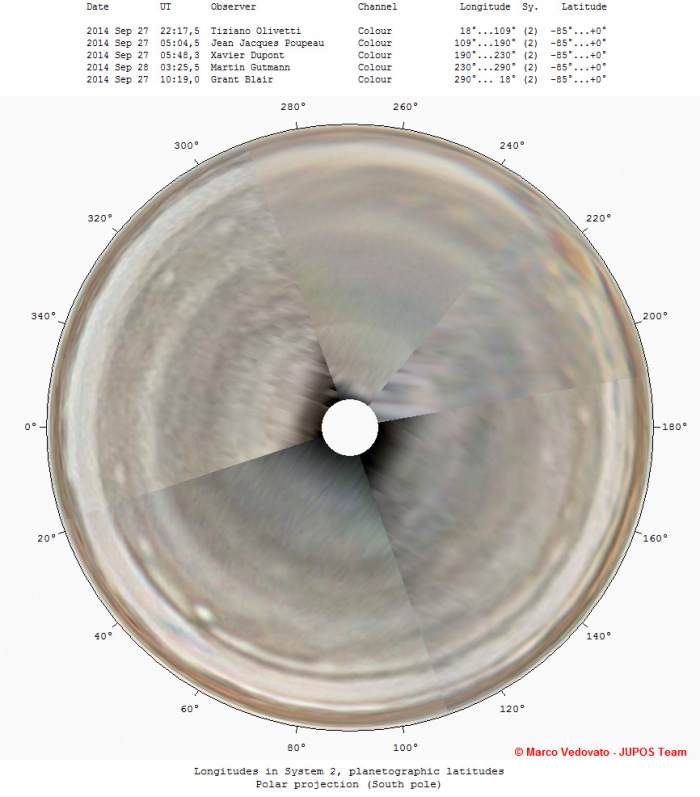Giove: mappa più recente
Da Sezione Pianeti UAI.
JUPITER: LATEST PLANISPHERES
Jupiter planispheres composed with images taken between 2014 October, 09-12
Maps prepared by Marco Vedovato with the software WinJUPOS.
Remarks about some visible features
SSTB Ovals - White spots at 40,5°S, long-lived anticyclonic circulations, named as A1, A2, A3 ... Their drifts lead them to overcome the GRS about once a year.
BA Oval - It is the result after the merging of three pre-existing ovals, during the year 2000. It is a large anticyclonic circulation, close to the latitude 33°S; in the year 2005 its color turned into a pale red. Its drift leads BA to overpass the GRS about every two years.
STB (South Tropical Belt)- Belt whose color intensity is variable as well as its latitude, variable in longitude.
GRS (Great Red Spot) - The edge is sometimes marked by a dark ring; nowadays the inner area has a pale red color. Its size is gradually shrinking.
SEB (South Equatorial Belt)- This belt periodically disappers, then an outbreak reinstates its ususal activity.
EB (Equatorial Belt)- Sometimes this thiny belt arises in the Equatorial Zone; it is a temporary feature: then the belt slowly disappears to born again during the more intensive periods of activity of the planet.
NEB (North Equatorial Belt) - This belt is the darkest one of the planet, active both in the inner area and in the edges. Periodically it broadens Northward and then it shrinks, about every four years, with production of white ovals and dark spots along the broadening edge.
WSZ (White Spot Z) - It formed in 1997, as one of the many (anticyclonic) white spots at the latitude 19°N. A long-lived spot, characterized by a fast prograding drift leading it to interacat with other spots sharing the same latitude, usually stationary in the System II. In the month of November 2013 its coloration turned into a light reddish tone .
NTB (North Tropical Belt) - As SEB and NEB, it is seat of periodical outbreaks of white spots and dark condesations, producing some veils in the neighboring zone (NTZ).
NNTB (North-North Tropical Belt) - Variable appearance by the longitude with some more marked dark sectors.
LRS (Little Red Spot) in NNTZ - Few visible but a long-lived feature; It formed at least in the year 1993. Is is palced at the latitude 40°N and periodically its red color becomes stronger.
Ovali SSTB - Macchie bianche a 40°S, vortici anticiclonici persistenti, che punteggiano queste fascia, denominati A1, A2, A3 ... Il loro moto li porta a sorpassare la GRS circa una volta all'anno.
Ovale BA - E' il risultato della fusione di tre ovali preesistenti, avvenuta nel 2000. E' un ampio vortice anticiclonico a circa 33°S, che nel 2005 si è colorato di una tinta arancio. Il suo moto lo porta a sorpassare la GRS ogni due anni.
STB - Fascia di intensità e latitudine variabile, a seconda della longitudine considerata.
GRS (Grande Macchia Rossa) - A volte definita da un contorno scuro, all'interno è debolmente colorata.
SEB - In questi anni la fascia è andata incontro a cicli di attenuazione, seguiti da eruzioni di attività che l'hanno riportata all'intensità solita.
EB - Periodicamente si è sviluppa una tenua fascia equatoriale; anche questo è un fenomeno periodico. La fascia poi lentamente svanisce e per riformarsi nei periodi di maggior attività del pianeta.
NEB - Questa fascia è la più scura del pianeta, attiva sia all'interno, sia ai suoi bordi. Periodicamente si espande verso nord e poi si restringe, fenomeno che si ripete con cadenza quadriennale, accompagnato dalla produzione di ovali chiari e macchie scure lungo il bordo in espansione.
WSZ (White Spot Z) - E' nata nel 1997, come una delle tante macchie bianche (anticicloniche) che appaiono a 19°N. E' caratterizzata, oltre che dalla longevità, dal moto veloce (verso longitudine decrescente), che la porta a interagire con altre macchie della sua latitudine, generalmente stazionarie nel Sistema 2. Nel mese di novembre 2013 ha assunto una debole colorazione rossastra.
NTB - Come la SEB e la NEB, è sede di periodiche eruzioni di macchie bianche e condensazioni scure, che producono velature nell'attigua zona (NTZ).
NNTB - Di aspetto variabile con la longitudine; presenta segmenti più marcati.
Piccola Macchia Rossa (LRS) in NNTZ - Poco appariscente, ma estremamente longeva: risale almeno al 1993. Si trova a 40°N, e periodicamente si colora in modo più intenso.





